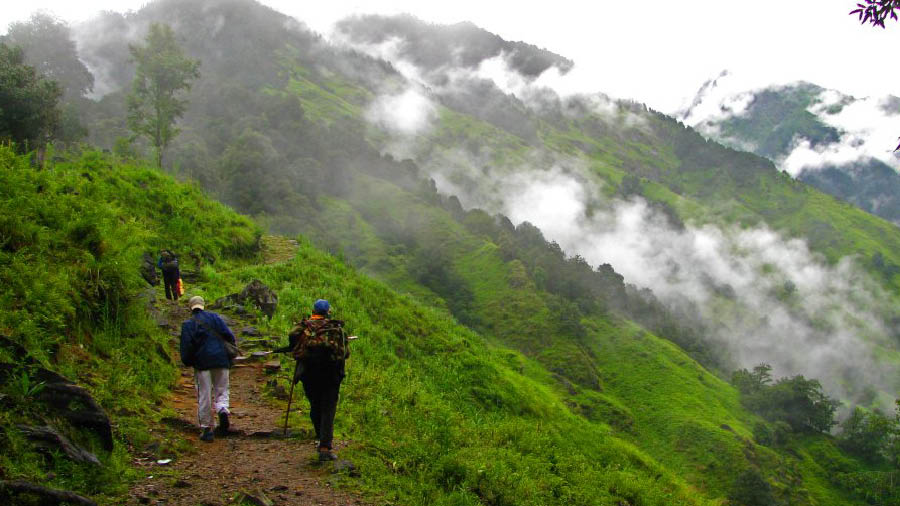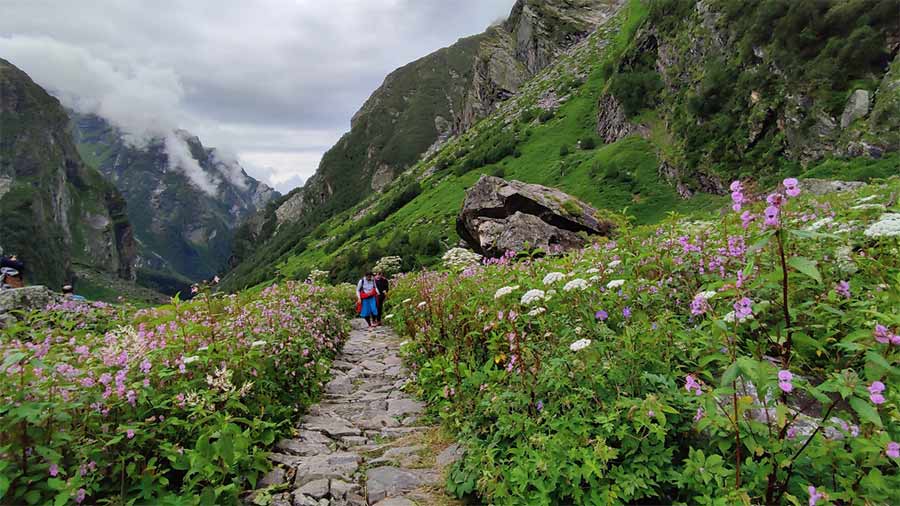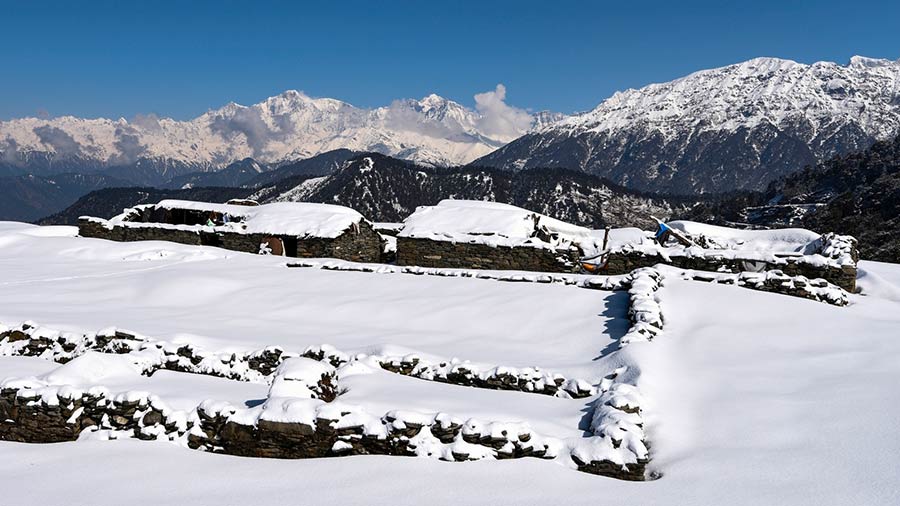Located at Garhwal region of Uttarakhand, Madhyamaheshwar (3,497 mt/11,473 ft ) is the fourth of the Panch Kedar temples. It is believed that after the battle of Kurukhsetra, the Pandavas sought Lord Shiva’s blessings to pardon them from the sins of killing their cousins. Lord Shiva, assuming the role of a bull, stayed at Guptkashi. The bull disappeared when the Pandavas tried to hold on to it. It reappeared later at five places — the Panch Kedars. The stomach of the bull appeared at Madhyamaheshwar and hence the name (Madhya – middle, Maheshwar – Lord Shiva).
The ideal season for trekking at Madhyamaheshwar is October and November, but then you miss the flowers and the lush greenery of the valley. In August, the rain makes it one of the most beautiful treks that you can ever imagine.
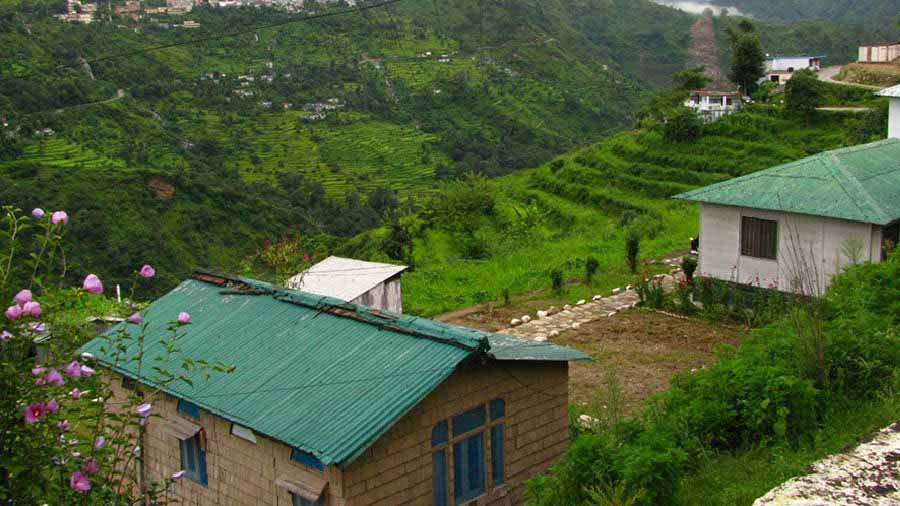
Huts of GMVN tourist lodge at Ukhimath
I drove to Rudraprayag with my friend Nishesh Singh, amidst torrential rain on the same day we had reached Haridwar by Doon Express. From Rudraprayag, we changed vehicles to reach GMVN tourist lodge of Ukhimath.
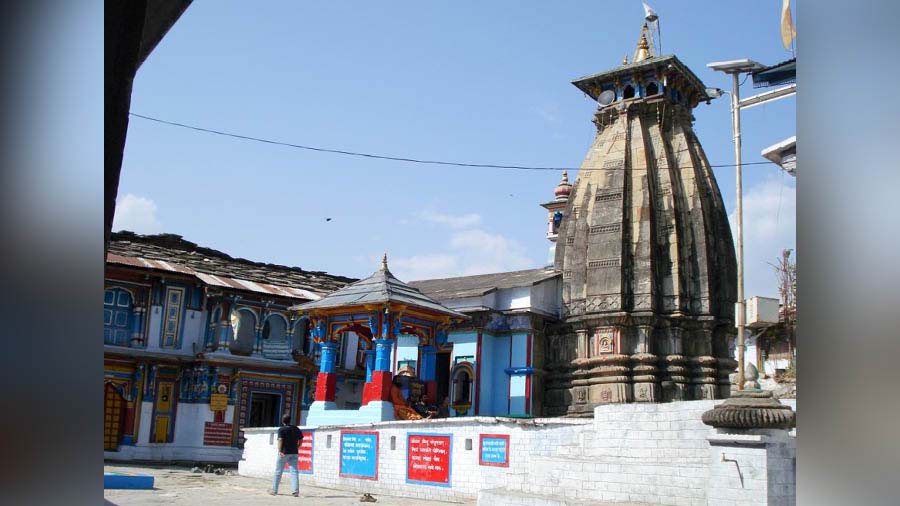
Omkareshwar temple at Ukhimath Vibhuti Venkat Nataraj, Wikimedia Commons
There is an Omkareshwar temple at Ukhimath, which dates to the time of Mandhaata, ancestor of Rama, where the idols of Kedarnath and Madhyamaheshwar are brought down during winter in a spectacular procession called ‘Doli Yatra’. It is believed that the wedding of Usha (daughter of Vanasur) and Aniruddh (grandson of Lord Krishna) took place here.
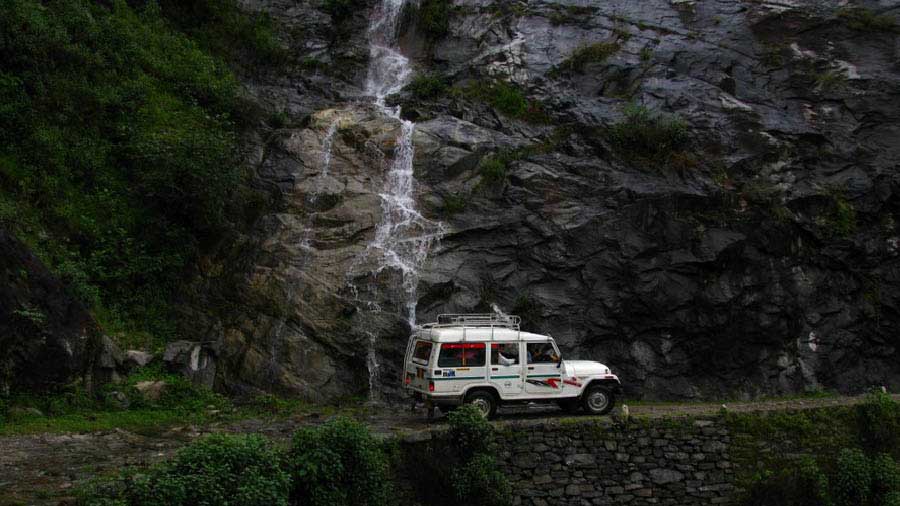
The drive from Ukhimath to Ransi via Uniana is about 1.30 hours duration
Next day, we took a one-and-a-half hour drive to Uniana from Ukhimath with our guide Shankar Singh. At present, the metal road has been extended up to Ransi, a small settlement located 3km ahead of Uniana.
Within minutes of starting the trek from Uniana (1,700 mt) it started raining. The rain went from bad to worse and we decided to stop at Ransi. Ransi has a small temple of Rakeshwari Devi.
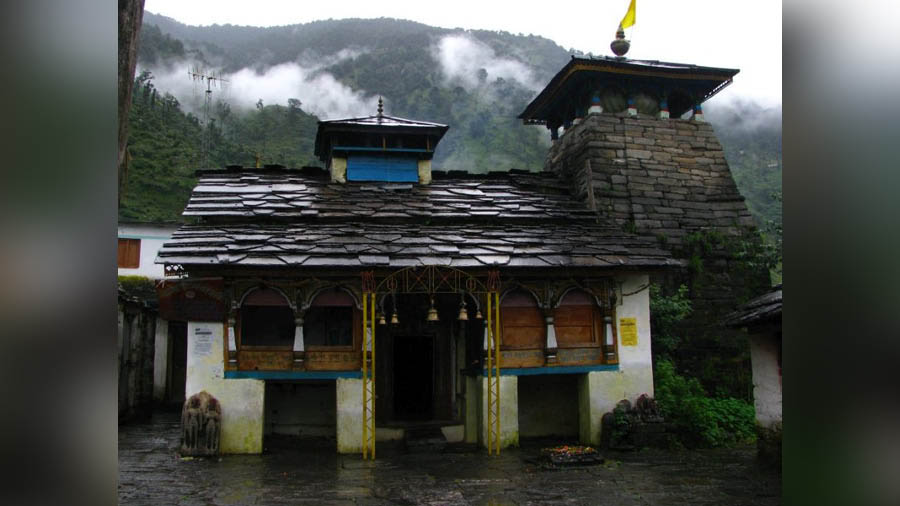
Ransi has a small temple of Rakeshwari Devi
The rain slowed down and we started after paying a visit to the Rakeshwari Devi Temple. The path was muddy and slippery and we had our share of occasional falls. There were numerous waterfalls on the way at their gurgling best. Crossing a wooden bridge, we looked in awe at a huge waterfall gurgling down. The village of Gaundar is a few steps away from this waterfall. This was our first stop.
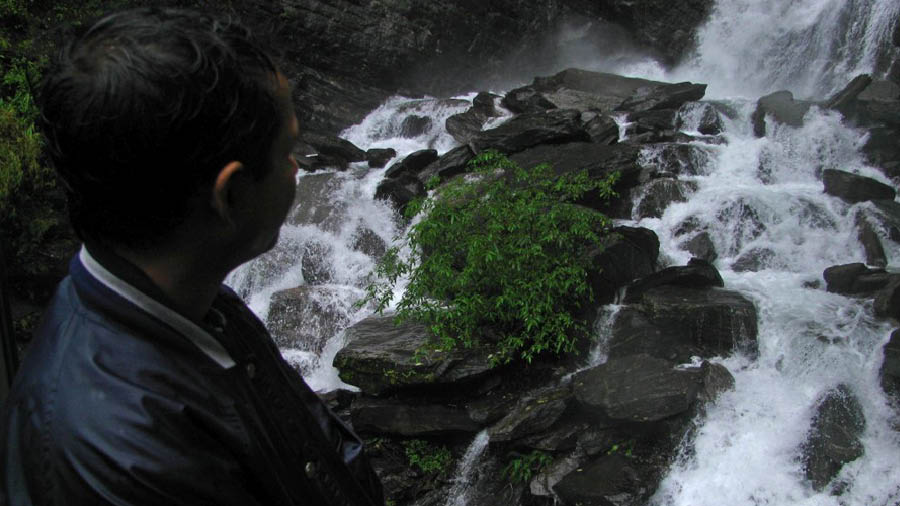
Trekking from Uniana towards Gaundar in the rain Nishesh Singh
After having lunch and changing clothes, we proceeded towards Bantoli (1,800 mt), 1.5km from Gaundar. There are many places to stay at Gaundar, but Balbir Singh Panwar’s Vishwa Lodge, which is on the top of a hillock, is recommended for its view of the confluence of Madhyamaheshwar Ganga and its tributary Markandeya Ganga.
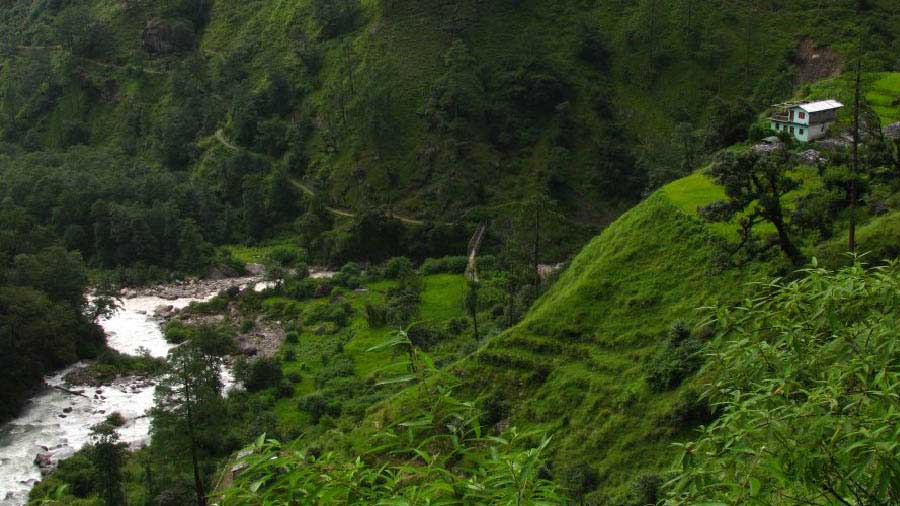
Vishwa Lodge on extreme right atop of a hillock at Bantoli. The lodge has expanded quite a bit in recent times
The rooms are clean and spacious too. We started at 6.30 am the next day for Madhyamaheshwar. The path was a constant uphill route. However, the spectacular cloudscape in the lush green valley with multicoloured unknown flowers made us forget the pain of the climb. Around 9 am, we reached our first halt at Nanu.
From Nanu (2,350 mt) it was a steep climb throughout. Thankfully, it was only drizzling. At Paikhamba (2,620 mt) we came across the densest jungle of the trek. The jungle path had lovely flowers soaked in raindrops. The climb was steepest from Kun (2,780 mt) and we reached Madhyamaheshwar at around 2.15 pm.
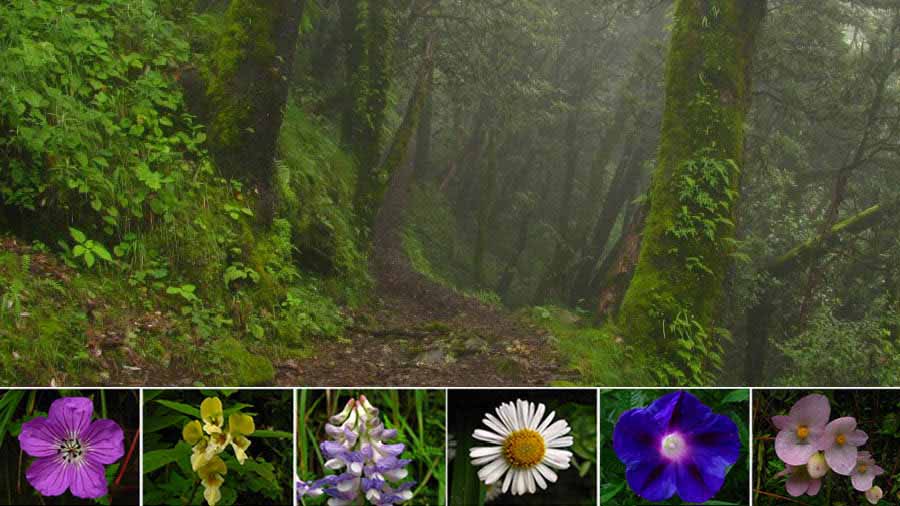
The jungle of Paikhamba. Inset shows the flowers we viewed in the jungle
Looking at the sky, we had little hope of seeing any snow-clad peaks the next day. Unlike Kedarnath, there are only a handful of staying options here, including the temple dharamshala. We settled for the night at Ashutosh Hotel. The evening aarti at the stone built Madhyamaheshwar temple was mesmerising.
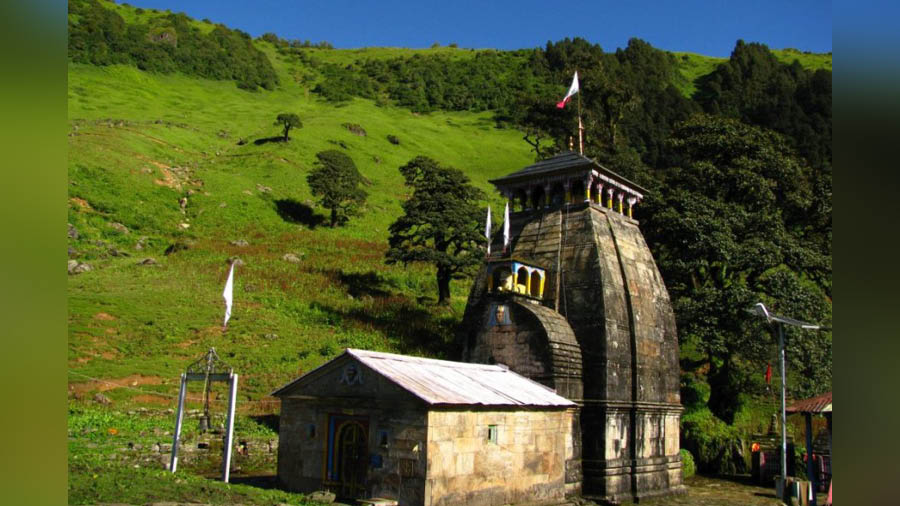
The temple at Madhyamaheshwar, where the priests are of south Indian origin
I woke up at 4 am the next morning to find that some stars were visible. Taking a chance, we trekked along a steep climb up to the Bugyal (grassland) of Burha Madhyamaheshwar. There is a Shiva Lingam of Burha Madhyamaheshwar (here burha means ancient) inside its small stone shelter in the midst of the Bugyal beside a waterbody. A new enclosure has been built around it in recent times.
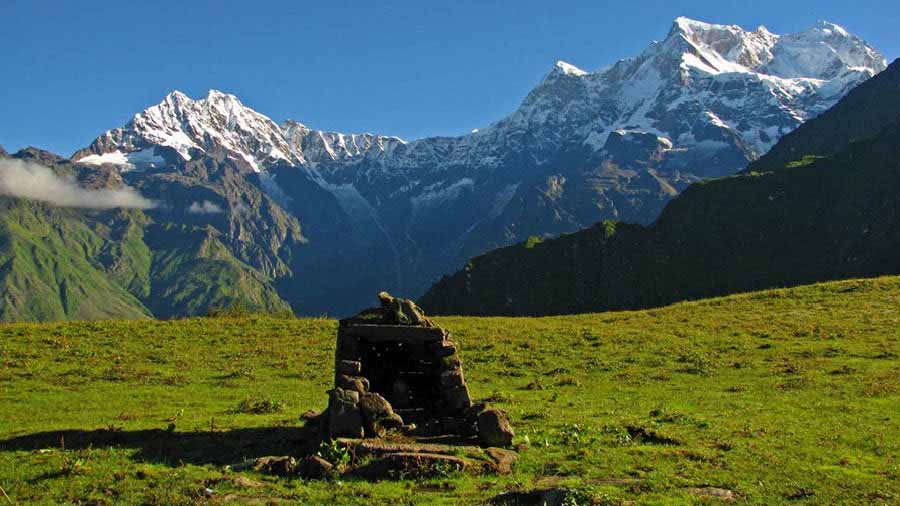
The small stone shelter housing the Shiva Lingam of Burha Madhyamaheshwar. In recent times a stone enclosure has been built around it
We waited hopefully to see even a glimpse of Chowkhamba despite dense clouds in the sky. Slowly the clouds cleared and finally it became miraculously sunny. We would see many snow-clad peaks, of which Chowkhamba, Mandani Twin Peaks, Kedar Dome and Sumeru were clearly identifiable. The reflection of the mountains on the waterbody makes the scenario heavenly.
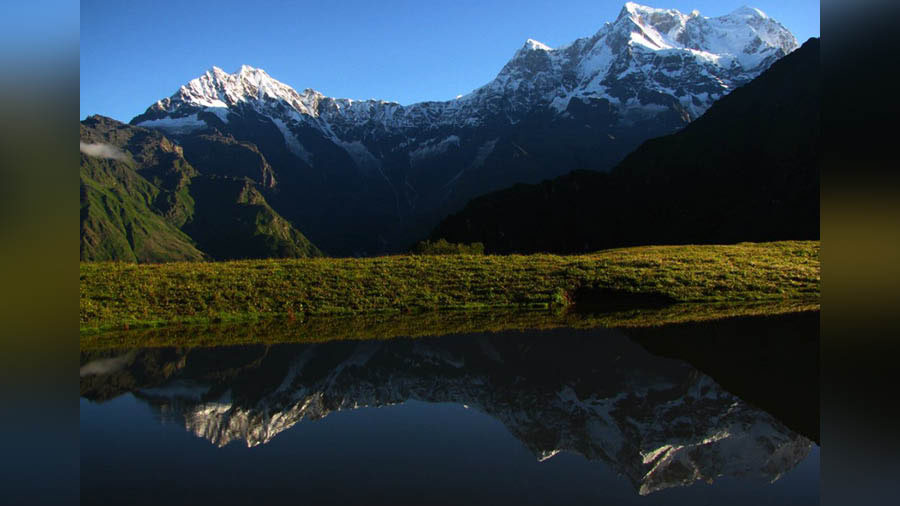
Reflection of (right) Chowkhamba and (left) Mandani twin peaks on the waterbody at the meadows of Burha Madhyamaheshwar
Later, the priest at the temple said that this sunshine was a miracle. There had been no sun for the last 45 days in this area. It is said that if you ask for anything at Madhyamaheshwar Temple, you will get it. However, I could not ask for anything. What more can you ask from a God who does miracles for you, without even asking for it.
Travel information:
· From Kolkata, reach Haridwar by Doon Express or by Kumbh Express. From there, reach Ukhimath via direct bus, or in a shared car via Rudraprayag and Kund. It takes around 7- 8 hours to reach Ukhimath.
· One of the best places to stay at Ukhimath is GMVN tourist huts.

Kedar dome and (right) Sumeru, as seen from the meadows of Burha Madhyamaheshwar
· With average stamina, it takes a minimum 3 to 4 days to complete the Madhyamaheshwar trek.
· There are only basic staying options in the trek route. Food available is vegetarian. Most of the rooms have attached restrooms.
· Electricity is stable till Bantoli, after which it is only solar power.
· Only BSNL and Jio connectivity are available after Ransi.
